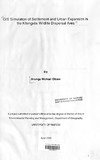| dc.description.abstract | Over the years settlement within the Kitengela Wildlife Dispersal Area, hereafter
referred to as KWDA has increased with high numbers of people continuously
moving into and settling in the area. This area has therefore continued to witness
both local and foreign influence with immigrants bringing with them foreign
practices such as agriculture, quarrying and constructions of new settlements to
an area that has largely been utilised by livestock and wildlife utilisation.
This study attempted to utilise spatial statistics, remote sensing and Geographic
Information System (GIS) to examine some of these forces of land use change
particularly, agriculture, settlement and urban expansion in the KWDA by
examining the effects of the biophysical characteristics of the area. The study
aimed at identifying areas where land use change had taken place using satellite
imagery and linking these to significant biophysical variables thought to influence
these changes. These variables were then used in a model to predict future
expansion of settlement and urban centres together.
Results indicated that the occurrence of settlement and agricultural activities in
this area were driven mainly by proximity to certain infrastructural facilities such
as roads, man made water sources and towns and that areas near such facilities
were most likely to be converted either to agriculture or settlement areas away
from utilisation by livestock and wildlife which are the current practices.
The study concluded that with the rapid increase of human settlement coupled by
foreign economic activities, the KWDA, which is a life line to the Nairobi national
park, providing a dispersal area for wildlife during the wet season is likely to be
converted to either settlement or agriculture with disastrous effects to the park
unless urgent measures are taken to curb this situation.
Some of the recommendations include better incentives for conservation efforts,
proper legislation and wildlife corridor protection. | en |

